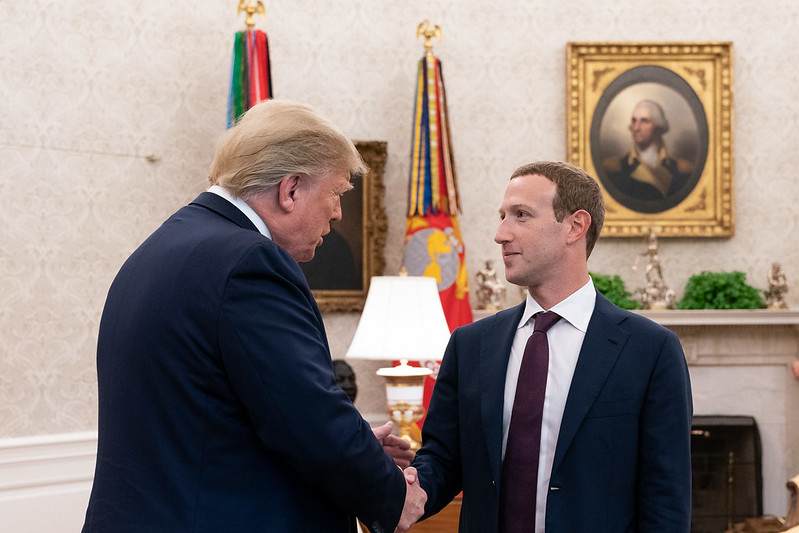Will Trump’s Executive Order Harm Online Speech? It Already Did.
The threat value of government investigations is all Trump needs to bend Twitter and company to his will.

Published by The Lawfare Institute
in Cooperation With

President Trump’s executive order on social media did its damage before he even put pen to paper.
The order comes just days after Twitter applied its fact-checking policy to a presidential tweet that contained misinformation about mail-in voting. The order directs the Federal Trade Commission (FTC) to review potential cases of anti-conservative bias on behalf of social media platforms under its Section 5 authority, a provision that gives the FTC the authority to sanction companies that engage in unfair or deceptive acts or practices. It also directs the Commerce Department to petition the Federal Communications Commission (FCC) to reexamine the scope of Section 230 of the Communications Decency Act. Though those directives have neither any legal footing nor any practical efficacy, the real danger of the order is that it represents a threat to social media companies that do not kowtow to Trump. The frightening thing is, that threat might be working.
Following a lengthy recitation about “selective censorship” on social media platforms, the executive order takes a number of actions against the platforms, particularly relating to Section 230 of the Communications Decency Act. That law protects online platforms from being sued based on their users’ content or their content moderation decisions. After laying out a “limited” (and incorrect) interpretation of that statute, the order instructs “all executive departments and agencies” to apply that interpretation and, in particular, instructs initiation of a rulemaking proceeding at the FCC to review potential ambiguity in the “good faith” element in Section 230(c)(2), which limits liability for removing content if the moderation was a voluntary action, as well as the bearing that this subsection has on the statute as a whole.
Additionally, the order promises to submit complaints of “incidents of online censorship” to the Department of Justice and the FTC, and directs the FTC to review these complaints and consider investigating companies for any unfair or deceptive acts or practices. The Justice Department is directed to establish a working group to explore potential enforcement of similar state statutes that prohibit unfair or deceptive acts or practices. The order also requires executive agiencies to review their advertising spending on social media platforms and the Justice Department to perform an assessment of whether “any online platforms are problematic vehicles for government speech due to viewpoint discrimination, deception to consumers, or other bad practices,” and instructs the attorney general to propose legislation “useful to promote the policy objectives of this order."
On the surface, the order has just enough grounding to worry the platforms. By coincidence of timing, Section 230 passed as part of the Telecommunications Act of 1996. This resulted in the codification of Section 230 within Title 47 and its incorporation into the Communications Act, the FCC’s controlling statute. Similarly, the FTC could theoretically bring a claim for unfair or deceptive acts if a platform promises to be an open forum but appears to have a bias against a specific class of users.
Neither logic holds up to legal scrutiny. The key language of Section 230—“No provider or user of an interactive computer service shall be treated as the publisher or speaker of any information provided by another information content provider”—leaves no ambiguity to enable FCC rulemaking or FCC action at all. Nor does language about good-faith removals limit this provision in any way. Rather, the statute simply lays out a standard for courts to review intermediary liability claims. Plus, even if the FCC could rewrite Section 230, that would not stop the Trump tweet fact-check—Twitter still enjoys First Amendment protection for what it says on its own platform. Regarding the FTC, the order wrongly interprets platforms’ merely aspirational guidelines on openness as mandatory promises; no one seriously believes that Twitter is totally neutral toward all content, no matter how horrible.
But the likelihood that the order won’t withstand judicial scrutiny misses the point. The threat of the order itself, even as wrong as it is, does exactly the damage Trump wants to do: It pressures companies into giving his content preferential treatment.
Over the next few months, Twitter and other platforms must gear up to fight the administration as it tries to twist the language of Section 230. They may be hauled in to FTC investigations over whether a removal didn’t occur in good faith or whether a company acted deceptively. These investigations almost certainly will exonerate the companies, but only after they shell out massive attorney fees. At least Twitter is big enough to afford all this; smaller platforms likely cannot.
And the final catalyst for all of this? Twitter decided to fact-check the president.
This thought will undoubtedly cross the mind of Jack Dorsey and other Silicon Valley CEOs: Wouldn’t it be easier to let him be? To give more leeway to rule-breakers and purveyors of misinformation? To do nothing in the face of campaigns of mistruth that undermine democracy and trust in government? Thus far, it appears that Dorsey will stand firm. The day after Trump issued the executive order, Twitter notably hid a tweet from the president threatening protestors in Minneapolis that “when the looting starts, the shooting starts.” However, many other platforms may ask themselves these same questions and find the fight is not worth the risks. For his part, Mark Zuckerberg preemptively capitulated to Trump’s executive order with a statement that Facebook “shouldn’t be the arbiter of truth of everything that people say online.”
The First Amendment allows private companies like Twitter to speak as they see fit and to fact-check leaders. But the executive order’s threats of changes to Section 230 and FTC investigations render the Constitution powerless to stop Trump from using the weight of the federal government to attack companies that criticize him.
Trump claims that he acts in the name of users’ First Amendment rights, that the platforms are the “21st-century equivalent of the public square” and as such must host all content equally. But Twitter, or even Facebook, is not so large as to squeeze out every other venue of online speech. Numerous alternatives exist. And notably, the incident that sparked Trump’s ire, the fact-checking of his vote-by-mail tweet, did not involve any suppression or censorship at all: Trump’s tweet remained up on the platform, with an additional note from Twitter. It is Trump, not Twitter, who is calling for suppression of speech.
For a party that advocates free speech and private enterprise, it is surprising to see Republicans come out in favor of regulating social media, interfering with free markets and business, and undermining private speech rights. This is particularly jarring given that social media has amplified conservative voices, especially more fringe views that may have been drowned out in the days when mainstream newspapers and broadcast stations generally controlled the flow of information.
This executive order doesn’t need to be legally sound. The threat is there, and that is enough. We now have government officials exerting their influence to strong-arm private companies and dictate how speech should be moderated online, in complete disregard for the First Amendment. And that is terrifying.






